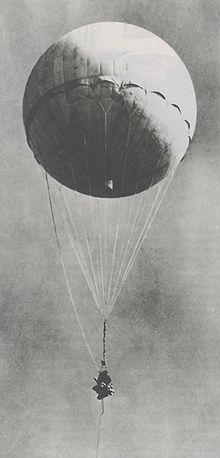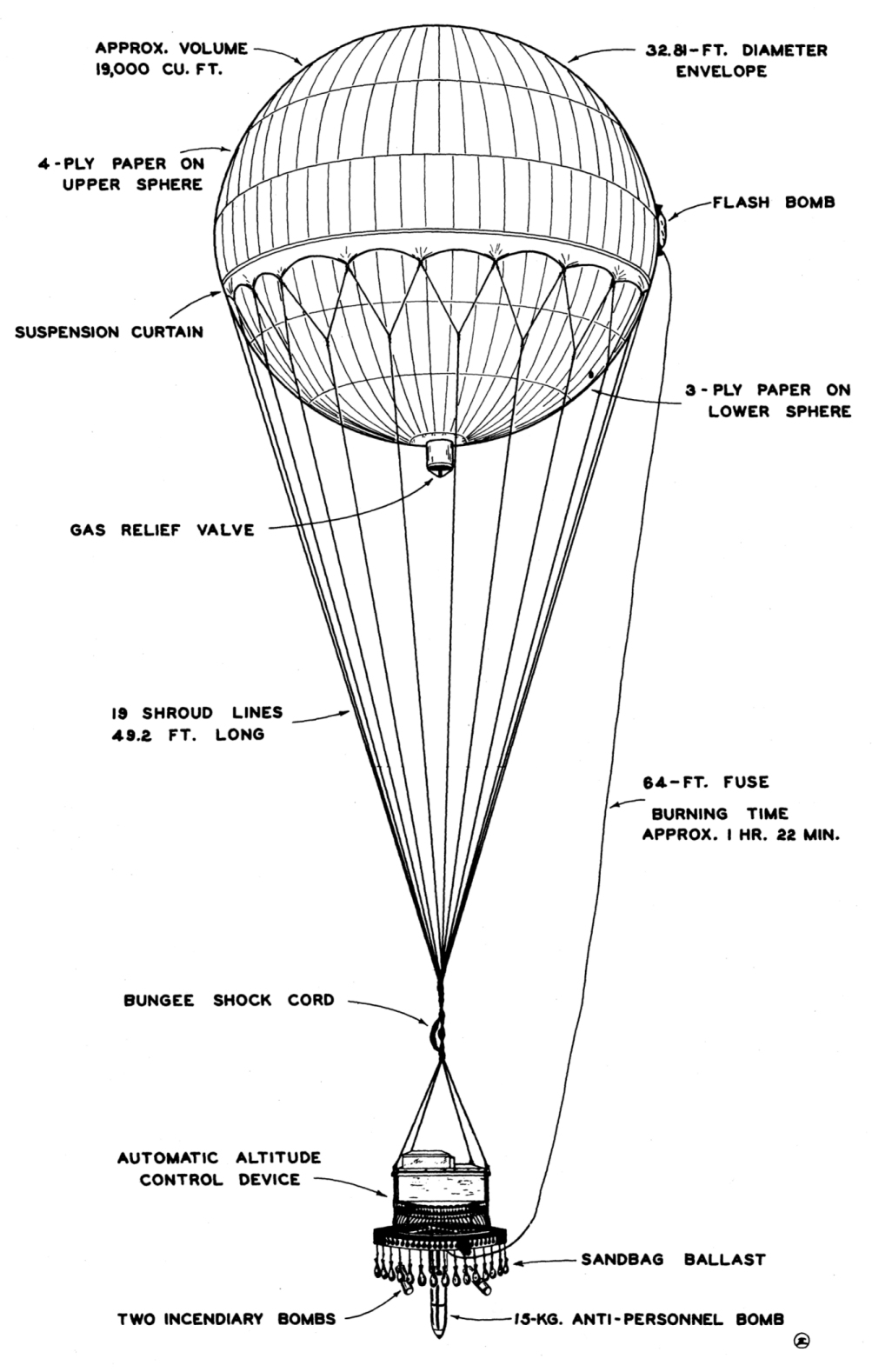The Curious History of
Japan's Balloon Bomb
Attack on America
Ross Coen
(University of Nebraska Press)

Less than four months after the war began, the Japanese were attacked by American bombers under the command of Jimmy Doolittle. Between them, sixteen B-25s dropped fifty 50-pound bombs on Tokyo, Yokohama, Osaka, Kobe and Nagoya. Shortly after, the Japanese vowed to have their revenge.
Using tree bark, glue, and intensive child labor, they produced a series of balloons that were sent up from the east coast of Japan, rising to 30,000 feet, moving across the Pacific in a great arc --- and arriving at the coast of America. They were called "fire balloons" or fusen bakudan (in Japanese military-speak, fu-go).
When they came to ground, it was expected that bombs would explode, fires would be set off, and --- in theory --- the great timberlands of the American Northwest would be set aflame.
The fire, the furore and the panic would destroy the morale of common Americans everywhere. With this unreasoning fear of a world ablaze, we would sue for peace and WWII would come to a successful and jubilant end, for all concerned.
The fireball machine was a towering beast with a diameter of thirty feet, running almost 100 feet from the top down to the payload. The balloon consisted of sophisticated automatic altitude control devices, anti-personnel bombs and two incendiaries.
The actual construction of the balloons began in the summer of 1944, and, by November, the Japanese were able to launch a series of fu-go from which --- according to the designers --- would bring them down on the innocents in the states of Washington, Oregon, and California.
Much to everyone's surprise, these giant Macy Thanksgiving Day Parade balloons were duly sent off, equipped with a complicated charge of fuses and sequentially-dropping sandbags (which would compensate for the balloons' rise during the heat of the day and their subsequent descent in the cool of the night).
These spectral beasts began appearing in the skies of the three states in late 1944 and, not long after, over Alaska, western Canada, and contiguous American states as far east as Michigan. They appeared out of the blue and some of them actually exploded, even though early spring is not the best time to set off forest fires what with the constant winter/spring rains. Still, in the six months that the program was underway, it was claimed that 9,000 "fire balloons" had been released, with a further 11,000 planned and under construction.
From the very beginning, the American military thought that news of balloons drifting in from so many thousands of miles away was not good for American morale. So many gas-bags dropping in uninvited on haystacks, blowing up piggies and exploding cows, falling in the fruited plains and banging up against hillsides was not to be permitted, much less to be spoken of. It was thought that this rain of fire would create the very panic that the Japanese were hoping for.
Thus, early on the Army make contact with newspapers and radio stations across the west, asked all concerned to keep the lid on the story of the Mysterious floaters from the East --- the very first Intercontinental Ballistic Missiles.
American newspapers and broadcasters quickly fell in with the military directives. Finally, on May 5, 1945, several family members were killed by a downed fire-balloon in a field just outside of Bly, Oregon. The Klamath Falls Herald and News asked the War Department to allow the newspaper to explain the source of the disaster, but they were told in no uncertain terms that they were to maintain silence. An editor at the Pendleton East Oregonian complained that this silence could only lead to panic, and suggested that not allowing warnings of these explosives would only further endanger the gentry. Consequently, the military issued a bulletin exactly nine paragraphs long, which was not to be "posted, published, or broadcast, only spoken aloud at the gatherings."
Fu-go is a decidedly odd offshoot of military history. The details of the balloon construction itself are strange and elegant. The paper was made of Washi --- the scrapings of the bark of the Kuzo tree --- which was then "boiled in a lye solution, rolled into balls and pounded." The man-hours --- rather the women-hours --- required was killing: young school girls labored twelve to fourteen hours a day to fabricate and glue together the light-weight fibre.They worked in darkened warehouse rooms to protect the secrecy of the project, were given little if any food and no time off. Thousands of fu-gos were constructed and shipped off to America.
The actual construction of the payload delivery system was exotic, with a series of "blowout plugs" connected by aneroids. It was a highly unorthodox design which, pre-computer, turns into a Luddite's delight: "The aneroids operated by responding to changes in atmospheric pressure. A thin disk made of flexible, corrugated metal lay flat against a moveable bar. The disk gradually flattened out under increasing air pressure and regained its original shape with decreasing pressure, moving the bar up and down accordingly . . . "
The blowing of the plugs also ignited a two-minute fuse that led to a set of jack switches on the direct opposite side of the wheel. The triggering of these switches armed the second pair of blowout plugs. If the balloon hadn't gained enough altitude in the two minutes since the first sandbags dropped, the still closed aneroid would blow this next set of plugs and release the second sandbag. The process would repeat, alternating from one side of the wheel to the other, until the balloon had lost enough ballast and ascended to an altitude where the aneroid opened and broke the circuit.
Fu-go carries some delightful surprises. The early balloons came with mysterious haiku packed with the bombs. One read,
Tiny
state of chemical
compound particle
the way to form
becoming sudden repetition
to adopt the way toThis devious message caused many a furrowed brow for those in the secret depths of the Pentagon, and --- as far as we can discover in the pages of Fu-Go, no one in the American military could comprehend the Oriental reasoning of sending a huge balloon soaring 7,500 kilometers to the east to induce a bonfire on the far mountaintops of the Rockies. The paranoid conviction was that the package must contain a diabolical poison to sicken a whole city, if not a whole nation. The American military suspected --- and continually tested for ---melioidosis, Japanese B encephalitis, Rift Valley fever, Aoki's disease (acute tularemia), anthrax, typhus, dysentery, psittacosis, variolla , . . . foot-and-mouth disease, and virus pleural pneumonia.
After months of proofing hundreds of the contents of the balloons, none of these were found. One military surgeon finally reported that he believed that soon enough the sand (used as counterweight and ballast) would be infected with psittacosis or foot-and-mouth disease . . . and actually seemed disappointed that the Japanese never packed any of these payloads in with their lovely white beach sand.
The military was so convinced of the nefarious nature of these exploding balloons --- and the consequent need to keep the truth from Americans --- that they damn near arrested Lyman Young (brother to the creator of the cartoon "Blondie") --- for a series of funnies he put out through King Features Syndicate called "Tim Tyler's Luck." Dr. Matsu Unkanni [!] was "an evil Japanese horticulturist who had developed a voracious, fast-growing plant and was now air-lifting the seeds to the United States as part of a plot to choke the entire continent." Shades of kudzu vine!
§ § § In all, over a six or seven month period, and as far as the U. S. Military could count, using fingers and toes, only seven percent of the balloons sent aloft actually made it, and that figure tends to be optimistic. Considering the odds --- mis-wiring, human error, storms, and the faulty gluing together in what was after all a rather porous organic gas-bag --- it's a wonder that any of these babies made it at all.
Helpful maps at the end of the volume show the wide swathe of those that did arrive on target (as it were). The range was enormous, running all the way from eleven that were shot up on Attu Island --- the only one of the Bering Islands actually invaded by the Japanese --- with another dozen or so in Alaska, five in the Yukon, several dozen in Washington, Oregon, and California (including two in Mexico) and a range of two or three each in Iowa, Nebraska, North Dakota, and Colorado.
The best guess given here is "342 balloon arrivals." Several were not tracked down until after the war was long over.
In all, fusen bakudan was a fairly captious project. To attempt to terrorize an entire subcontinent with a couple of thousand fright-bombs does seem to be stretching it a bit.
--- Pamela Wylie
